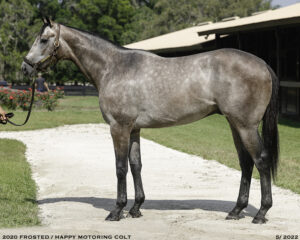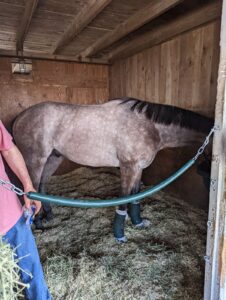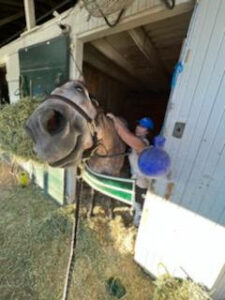Following Freezing Point
Following Freezing Point
By Siun Griffin, Equine Physiotherapist and Community Manager at London College of Animal Osteopathy (LCAO)
In this LCAO exclusive, International Diploma in Equine Osteopathy (Int’l DipEO) student, Randy Gootzeit, talks about her journey with her racehorse Freezing Point. She kindly took the time to answer some questions and share what issues Freezing Point had when she got him and how he has progressed over time with consistent treatment and dedicated teamwork with the horse’s trainer.
Why did you decide to begin the Equine Osteopathy program?
I like the idea of taking something back to improve the quality of movement in Thoroughbred racehorses.
How and when did Freezing Point come into your life?
A trainer I trust had looked for us to privately purchase a horse already racing, but there’s nothing like asking to buy a horse that suddenly makes the owner increase its price.

This led us to start looking at auctions of 2yo and older horses in training. We viewed more than 2000 videos over 4 months and 3 sales. I got outbid on our few selections; all but Hip #954 at the Ocala Breeders’ Sale in June 2022, Freezing Point.
His barn name is Snowball because we thought we had a snowball’s chance in hell of getting him due to his pedigree and workout speed of 10.3 sec for 1/8 mile.
Freezing Point is by Frosted, who ran fourth to American Pharoah in the Kentucky Derby and second in the Belmont Stakes. He set a stakes record for a mile the following year at Belmont, 1:32.73, and won and placed in other grade stakes before being retired. Freezing Point is from his 3rd crop to race. As of this month, Frosted is #3 on the list of third-crop sire earnings.
His dam, Happy Motoring, was a nonwinner in 6 starts, but she has produced two other winners so far.
When you first got Freezing Point what issues did you notice?
Freezing Point was raised to be sold at auction. As auction horses have to run at least 1/8 mile at speed, this could have had negative physical effects on him. Freezing Point was posting 10-second eighths as a young juvenile. He could have outrun his physical development.
We had seen that Freezing Point had high splints on all four legs. The splints happened really early in his training. These were well set and cold, and didn’t interfere with the suspensory apparatus.
He also has a left front cannon bone that is rotated laterally off the crooked knee, characteristic of sons and grandsons of Tapit (Frosted’s sire). The left front suspensory ligament is prominent at the medial ankle. He wings that leg at the trot, canter, and gallop. His action was smooth at all gaits, and his legs were cold.
How did you approach these issues and make a plan for the horse’s treatment?
Joe began to take him for long walks prior to training at the trot and gallop and followed with long walks (he got 6-11 miles of walking each day, besides his track training).
He was cooled out with ice water bandages to forestall inflammation and was done up on all four legs with a sweat of Furacin, DMSO, and alcohol. Recently, he only gets done up in front. This remains his routine.
Myofascial mobilization per Graston Technique Equine therapy was limited to 1-2 sessions each month from July through November. I practiced OAB palpation each month, as demonstrated by Prof. McGregor in the LCAO clinical unit.
What changes did you notice over the course of treatments?
When I saw him in early July, I noted that his thoracic trapezius looked like it was being pinched by the saddle, and he was a little tender to palpation at the thoracolumbar junction.
I replaced it with one with a wider half-tree soft back. I did some Graston Technique Equine therapy, a form of instrument-assisted soft tissue mobilization, through his neck, chest, shoulders, back, and hindquarters.


There was some fibrosis in his pectorals and biceps muscles on both sides and tension through his paraspinal
He received three treatments over 5 days, and this was followed up with manual stretching. He was tight on the right front into full knee extension at first.
July 5



By the time he got to the races in September 2022, he had full ROM at all limbs, back extension, and neck and head ROM. He loves to lie down and nap, and he stretches when he gets up.
His second race in mid-October was the first time he was pressed to run at top speed, due to an error in jockey judgment. His rectus abdominis and transverse abdominal muscles became palpably more massive after that effort.
He won the next race easily, and we gave him 6 weeks off to mature and recover from a solid year of training. He has an interesting way of going- he lengthens his stride to speed up, rather than quickening cadence.
He is currently back in training and is about 4-5 weeks away from a return to racing. His chest, shoulders, crest, and quarters have filled out. He’s a happy horse, his legs are cold, he has a full range of motion everywhere, and we consider ourselves lucky. I used the opportunity at my last visit to practice the OAB range of motion demonstrated by Prof. McGregor in the LCAO clinical unit.
As of this interview, Freezing Point is nominated for the American Triple Crown Series.
Randy recently purchased another racehorse – War Room. We will follow his journey in an upcoming series to be published in the coming weeks.
Click twice on the video below to watch Freezing Point owner, Randy Gootzeit performs Osteopathic Articular Balancing technique on the horse’s forelimb.
For more information on the International Diploma in Equine Osteopathy (Int’l DipEO) program, click here

